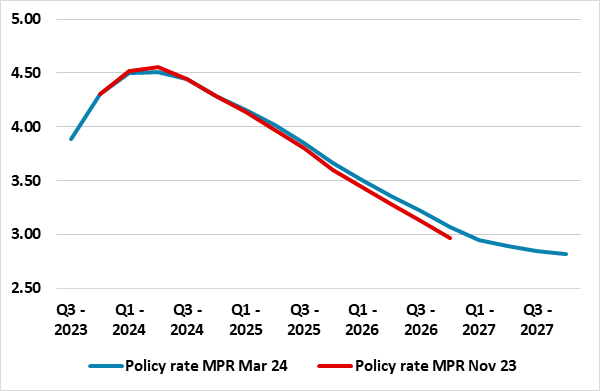Norges Bank Review: Unrevised Rate Cutting Hints?
Surprising few, the Norges Bank Board left the policy rate at 4.5% for a second successive meeting and even retained the thinking first aired at the December meeting, namely the ‘policy to stay on hold for some time ahead’ rhetoric. It accepted a softer recent inflation backdrop but revised up its real activity backdrop so that the recent price undershoot dissipated through 2025 due to a smaller output gap (Figure 2). Indeed, it adhered to its existing policy rate projection suggesting no cuts before this autumn Figure 1), actually envisaging a little firmer path out through 2026, but still a likely terminal rate of around 3%. However, it is clear that the Board is uncertain, not only due to the wide differences across industries through the Norwegian economy to a degree that it is still accepting a possibility of having to hike further. But the overall policy outlook is still balanced as it weighs risks of earlier easing (hurting the currency) against waiting too long. Not least against a backdrop where the updated projections seem to take no account of likely looming rates cuts by other central banks, we think he Board is being too cautious and we still think rate cuts may arrive by mid-year, especially given the more recent drop in underlying price pressures.
Figure 1: Rate Path Profile Not Yet Trimmed?

Source: Norges Bank
The Board judges that a policy rate path broadly consistent with the forecast in the November Report provides a reasonable trade-off between the objectives of monetary policy. Regardless, the smaller output gap (that now only appears next year rather than this, is seemingly a reflection of the slightly sturdier GDP backdrop of the last year but is still somewhat puzzling. Obviously, this generates a firmer-than-otherwise inflation outlook, and one that keeps inflation (CPI-ATE) above the 2% target throughout the forecast horizon, ie out to 2027. That the Board is still considering starting to cut rates and then keep easing, may be an indictment of this inflation projection with the Board instead basing policy on risks than firm projections.
This may as much reflect not only the improved inflation picture of late but a realization that with many other DM central banks implying a potentially imminent rate cut cycle may mean that the Norges Bank may have to follow suit. Admittedly, the Bank may feel it can/should defer rate cuts into H2 as this may help support the still weak krone, but this runs the risk of accentuating a weak economy, encompassing near record consumer confidence fragility that may be the underlying factor being recent currency weakness.
How Restrictive?
It is clear that the Bank now assesses that the policy rate is now sufficiently high amid a clear recognition that the current stance is restrictive. Indeed, the question being how recent data may remould the Board’s view of how long policy needs to stay at current restrictive levels. Notably, as admitted, underlying inflation has declined further and that economic growth is weak, the latter very much underscored by continued very weak consumer confidence readings.
Inflation Dynamics Shifting Clearly
Indeed, February data saw both the headline and underlying inflation rate decline to 18-month lows. Notably, the CPI-ATE measure, which excludes volatile items such as energy, fell to 4.9% y/y last month, well below the pick-up to 5.5% which the Norges Bank had projected. The weakening trend of recent months is even clearer in terms of seasonally adjusted m/m numbers for both CPI-ATE and a more formal core measure (ex food and energy) which we compute. Indeed, these are now running at a pace very much consistent with a clear undershoot of target, something evident in other DM economies and which we think at least (in the current juncture) is a result of an easing in supply problems. It is against this backdrop that the Board can weigh whether with the 450 bp cumulative tightening still to have anything like its full impact, it can start to make the policy setting less restrictive, as it anticipated weakness demand supporting the recent disinflation process.
Notably, amid market expectations envisaging policy easing only toward the end of the next six months, gives the Board a little more policy flexibility, albeit with no clear signs that there was a great appetite to exercise this.
Figure 2: Output Gap Made Smaller Somewhat Puzzlingly

Source: Norges |Bank
Indeed, we have long thought the Norges Bank has been too hawkish, not least given its own projection of an output emerging and then gap of persisting out to 2026. This output gap picture will weigh (further) on inflation and to a degree that makes us envisage a 25 bp cut in June. Admittedly, this is actually less of a cut than what we were previously anticipating for the whole of next quarter, but it is still more than markets and of course the Norges Bank have yet to pencil in. Regardless, we still forecast 100 bp of rate cuts in 2024 and a same-sized drop through 2025.